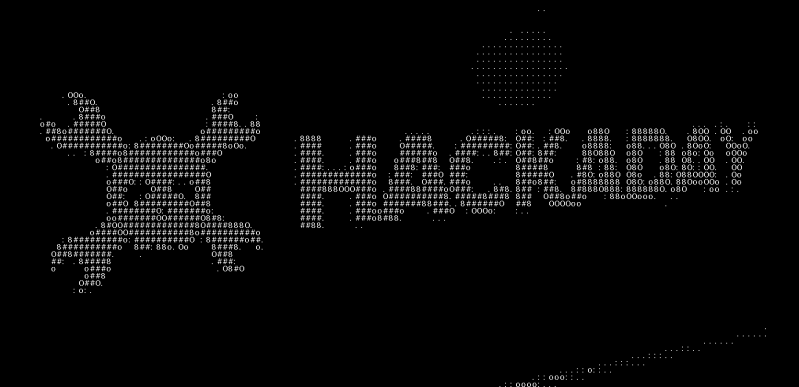We admit it, we have a nostalgic soft spot for ASCII Art. Pictures made form characters, printed on an old-fashioned line printer. They’ve been a hacker standby since the 1960’s. Times have moved on though. These days we’re all carrying supercomputers in our pockets. Why not use them to create more great ASCII art? That’s exactly what [Brian Nenninger] did with AsciiCam. AsciiCam lets you use your Android phone’s camera to create ASCII images.
Using the software is simple. Just launch it and you’re greeted with an ASCII preview of the camera image. Users can select from a 16 color palette and full 24 bit color. Monochrome modes are also available. You can also choose from black text on a white background or white text on black.
The great thing about AsciiCam is the fact that it is open source. You can download the full source code from Github. If you just want to run the software, it’s available through the Google Play Store. This is a labor of love. The first Github commits were six years ago, and [Bran] is still working — the most recent commits were made only a few days back. AsciiCam is also a good example for neophyte Android programmers.
Want to know more about ASCII art? Check out Al’s history of ASCII art, or this talk about both ASCII and ANSI creations.
















I’ve had this installed for years…
Same, it’s pretty good for a free app, but it’s buggy on every device I’ve ever tried to run it on. Weird stuttering in the preview and sometimes crashes. Even so it always in my camera folder on my home screen.
Aalib has been around long enough to vote in the US: http://aa-project.sourceforge.net/aalib/
“We admit it, we have a nostalgic soft spot for ASCII Art.”
Yeah, other people’s art. For some reason mine always ended up sucking.
Hmmm… an article about a link to a github project page, which does not contain any information other then the sourcecode and a link to google play.
The hackaday article (not the project) to me feels like: “here is an app and here is some code find out for yourself, we from hackaday don’t want to spend any time on it, we don’t care about algotithms or technical choices the programmer made…”
Which is a pitty, as the project seems promissing. I don’t care in installing every app someone else mentions as interesting. Because since the internet took off people find monkeys scratching their but and falling off a tree very interesting also…
Please hackaday, put more effort into this article, I think it deserves it!
For any other commenters. If they know about some decent description about the algortithms involved in converting images into ASCII (or any other kind of charset) please let us all know.
PS: some time ago I’ve attempted to convert images into PETSCII (Commodore ASCII) and ran into this problem, I’ve ended up in comparing the matching pixels of the 8×8 grid of the image with the 8×8 pixels of the font, making up a table of the number of matching pixels for each character and then picking the first from that table that has the highest score. Very simple, it worked, but I always felt it could be done more elegantly. So when I noticed this article on hackaday I thought, wow I could learn something from this, but the info is not very well presented by this article. So I have to find out for myself an dig into the code… hoping it’s algorithm is better then mine and if not I wasted a few hours
I dont really see the issue?
You want more info, but you dont want to look for it?
Heres a link to a specific file on that github repo to get u started
https://github.com/dozingcat/AsciiCam/blob/master/app/src/main/java/com/dozingcatsoftware/asciicam/AsciiConverter.java
thanks for the link/info. But you didn’t get my point, what I really meant that it would have been nice if hackaday would have put more effort in this article. They just put up a link to github and that was it, no background, no technical details, how should this inspire others?
ASCII Art is certainly relevant today! It is often used for Boot/Console/FTP/SSH/SFTP/SCP startup/login banners in Linux/Unix operating systems. Modified default “Message Of The Day)” MOTD file(s) with ASCII art is often used as evidence you have hacked and own a system (a.k.a. PWN – for the Youngsters). Plus anyone who’s dealt with a (e.g.) CRACK executable to defeat DRM has seen ASCII Art many times in the accompanying README file.
There are LOTs of stand-alone and online applications to convert images to ASCII Art. But BE CAREFUL! Never use an application that converts to an image format (e.g., jpg etc.), you will not only be exposed to tracking via the image metadata, it is very possible the resulting image will contain embedded information itself (e.g., Steganography) – outside your knowledge. Unique unwanted information may also be embedded by the application if the output is just an ASCII file (easier to detect).
A simple recommendation is for a system builder/owner to MODIFY all the MOTD type files in a known trusted system. Many simple attacks try to mask their presence yet remain trackable by modifying the MODT file(s) in non easily user-detectable ways. By having very different unique MODT file(s), you may easily detect if they have been changed by an attacker (diff at boot helps). But remember, a positive result means it’s too late.
Wow, you think Sony and such are actually releasing fake ASCII art apps to embed stenographic info in jpegs in the vague hope of catching a hacker?
We know these people go far, but in the past they’d rather fuck over every person on earth to get their way as opposed to vague hope on obscure apps used by a dozen people max.
Found this for iOS: https://github.com/oxling/iphone-ascii/tree/master/ASCII